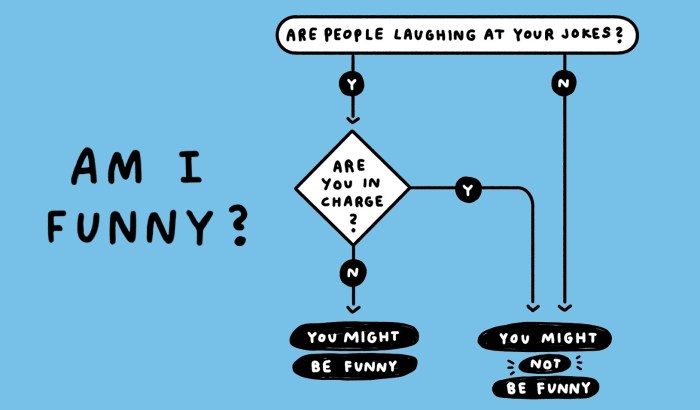Looking at humor from a structural-functional viewpoint jokes unveils a fascinating perspective on the mechanics of humor. This approach analyzes jokes as structured narratives with specific components that contribute to their humorous effect, providing insights into the cognitive and social processes underlying humor appreciation.
By examining the structural elements of jokes, such as setup, punchline, and incongruity, we gain a deeper understanding of how these elements interact to create a humorous response. This analysis reveals the role of surprise, incongruity, and cognitive biases in shaping our perception of humor.
Structural-Functional Perspective of Humor in Jokes

The structural-functional viewpoint analyzes humor by examining the structure and function of humorous content, such as jokes. Within this framework, jokes are seen as a form of verbal art that serves specific social and psychological functions.
Jokes typically consist of a setup that establishes a context or expectation, followed by a punchline that violates or subverts that expectation. This incongruity between setup and punchline creates a humorous effect.
Functional Analysis of Joke Structure
The key structural components of jokes include:
- Setup:Establishes a context or expectation.
- Punchline:Violates or subverts the setup’s expectation.
- Incongruity:The discrepancy between setup and punchline that creates humor.
These components work together to create surprise and incongruity, which are essential for the humorous effect.
Cognitive Processes in Humor Appreciation
Understanding and appreciating jokes involve several cognitive processes:
- Schema theory:Jokes often rely on shared knowledge and expectations (schemas) to create humor.
- Pattern recognition:Jokes exploit patterns and sequences to build anticipation and surprise.
- Mental flexibility:Jokes require the ability to shift perspectives and make connections between seemingly unrelated concepts.
Cognitive biases, such as selective attention and confirmation bias, can also influence humor appreciation.
Social and Cultural Context of Jokes
Humor in jokes is heavily influenced by social and cultural factors:
- Shared norms:Jokes often reflect and reinforce shared social norms and values.
- Cultural beliefs:Jokes can express or challenge cultural beliefs and stereotypes.
- Contextual cues:The context in which a joke is told can impact its reception and interpretation.
Jokes that reflect specific cultural contexts may not be as humorous to those outside that culture.
Design a Table Comparing Different Types of Jokes Based on Their Structural Features, Looking at humor from a structural-functional viewpoint jokes
| Joke Type | Setup | Punchline | Structural Analysis |
|---|---|---|---|
| One-liner | A short, self-contained joke with a single punchline. | “What do you call a fish with no eyes?””Fsh!” | Setup: Establishes a context.Punchline: Violates the setup’s expectation with a surprise twist. |
| Knock-knock joke | A joke that begins with a knock-knock sequence. | “Knock, knock.””Who’s there?””Interrupting cow.””Interrupting c–“ | Setup: Establishes a pattern and anticipation.Punchline: Subverts the pattern with a surprise interruption. |
| Anti-joke | A joke that deliberately fails to meet expectations. | “What’s the best thing about Switzerland?””I don’t know, but the flag is a big plus.” | Setup: Creates an expectation of a humorous punchline.Punchline: Subverts the expectation with a non-humorous or absurd statement. |
Create a Bulleted List of Methods Used to Analyze Humor in Jokes
- Structural analysis:Examines the joke’s setup, punchline, and incongruity.
- Functional analysis:Explores the social and psychological functions of the joke.
- Cognitive analysis:Investigates the cognitive processes involved in understanding and appreciating the joke.
- Discourse analysis:Analyzes the linguistic and conversational features of the joke.
- Cross-cultural analysis:Compares jokes from different cultures to identify cultural influences.
Q&A: Looking At Humor From A Structural-functional Viewpoint Jokes
What is the structural-functional viewpoint in humor analysis?
The structural-functional viewpoint analyzes humor as a structured narrative with specific components, such as setup, punchline, and incongruity, that contribute to its humorous effect.
How do jokes fit within the structural-functional framework?
Jokes are a type of humorous narrative that can be analyzed using the structural-functional viewpoint. By examining the structural elements of jokes, we can identify how they create a humorous response.
What are the key cognitive processes involved in humor appreciation?
Cognitive processes such as schema theory, pattern recognition, and mental flexibility play a crucial role in understanding and appreciating jokes. These processes help us make connections between the different elements of a joke and recognize its humorous intent.